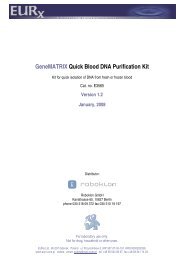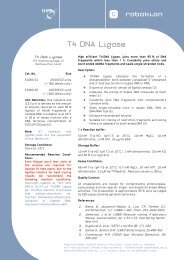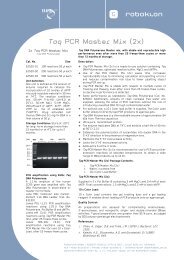GeneMATRIX Plasmid Miniprep DNA Purification Kit - roboklon.de
GeneMATRIX Plasmid Miniprep DNA Purification Kit - roboklon.de
GeneMATRIX Plasmid Miniprep DNA Purification Kit - roboklon.de
You also want an ePaper? Increase the reach of your titles
YUMPU automatically turns print PDFs into web optimized ePapers that Google loves.
<strong>GeneMATRIX</strong> <strong>Plasmid</strong> <strong>Miniprep</strong> <strong>DNA</strong> <strong>Purification</strong> <strong>Kit</strong><br />
<strong>Kit</strong> for isolation of high-purity plasmid <strong>DNA</strong> (1.5-4 ml bacterial culture)<br />
Cat. no. 3500<br />
Version 3.1<br />
January, 2008<br />
Distributor:<br />
Roboklon GmbH<br />
Kantstrasse 65, 10627 Berlin<br />
phone 030 318 09 372 fax 030 310 19 197<br />
For research use only.<br />
Not for drug, household or other uses.<br />
EURx Ltd. 80-297 Gdansk Poland ul. Przyrodnikow 3, NIP 957-07-05-191, KRS 0000202039,<br />
www.eurx.com.pl or<strong>de</strong>rs: email: or<strong>de</strong>rs@eurx.com.pl tel. +48 58 524 06 97, fax +48 58 341 74 23
Note 1: Once the kit is unpacked, store components at room temperature, except buffer CellR, which should be<br />
stored at 2-8 o C. This will ensure the best performance, due to preserving activity of RNaseA inclu<strong>de</strong>d into the<br />
buffer. In case of occasional buffer ingredients precipitation, simply warm up in 37 o C water bath, until clarified.<br />
Note 2: All solutions should be kept tightly closed to avoid evaporation and resulting components concentration<br />
changes.<br />
Protocol<br />
1. Apply 40 µl of activation Buffer PX onto the spin-column (do not spin) and keep it at room<br />
temperature till transfering lysate to the spin-column.<br />
Note 1: Addition of Buffer PX onto the center of the resin enables complete wetting of membranes and maximal<br />
binding of <strong>DNA</strong>.<br />
Note 2: The membrane activation should be done before starting isolation procedure.<br />
2. Pour cells from overnight culture (11-14 h) into 1.5-2 ml tubes. Spin down 1.5-4 ml in a<br />
microcentrifuge at app. 14,000 rpm for 2 minutes. Pour off the supernatant and blot tubes<br />
upsi<strong>de</strong>-down on paper towel to remove any remaining media.<br />
Note 1: E.coli strains recommen<strong>de</strong>d for plasmid isolation have endA - genotype, such as: DH5a, DH1, JM103-109,<br />
XL1-Blue, MM294 and C600. While endA + strains, such as BL21, RR1, DH11S, JM101, HB101,TG1 and TB1 can<br />
also be used, but they yield lower quality <strong>DNA</strong>.<br />
3. Add 250 µl of Cell R buffer and completely resuspend the cell pellet.<br />
4. Add 200 µl of blue-coloured LysisBlue buffer. Mix gently, but completely by several-fold<br />
inverting, until uniform blue colour of cell resuspension is obtained.<br />
Note 1: Alkaline LysisBlue buffer contains SDS, which can precipitate at temperatures below 20 o C. In this case<br />
warm the buffer up in 37 o C water bath, until clarified.<br />
Note 2: Forceful mixing should be avoi<strong>de</strong>d, as it can cause irreversible <strong>de</strong>naturation of plasmid <strong>DNA</strong> molecules as<br />
well as contamination with genomic <strong>DNA</strong> fragments.<br />
5. Add 350 µl of neutralization and binding buffer Neutral-B. Mix by several-fold inverting, until<br />
blue colour will disappear.<br />
6. Spin down in a microcentrifuge at app. 14,000 rpm for 7 minutes.<br />
7. Pour the supernatant from step 5 into the spin-column placed in the receiver tube.<br />
8. Spin down at 12,000 rpm for 1 minute.<br />
9. Remove the spin-column, pour off supernatant and place back into the receiver tube.<br />
10.Add 500 µl of PX buffer and spin down at 12,000 rpm for 1 minute.<br />
2
11.Remove spin column, pour off supernatant, replace back spin-column.<br />
12.Add 650 µl of Wash-PX buffer and spin down at 12,000 rpm for 1 minute.<br />
13.Remove spin column, pour off supernatant, replace spin-column.<br />
14.Spin down at 12,000 rpm for 2 minutes to remove traces of the Wash-PX buffer.<br />
15.Place spin-column into new receiver tube (1.5-2 ml). Add 50-100 µl of Elution-PX buffer to<br />
elute bound <strong>DNA</strong>.<br />
Note 1: Addition of eluting buffer directly onto the center of the membrane improves <strong>DNA</strong> yield.<br />
Note 2: To improve recovery of larger plasmids (above 6 kb) it is recommen<strong>de</strong>d to elute with buffer heated to 80 o C.<br />
Note 3: For elution of <strong>DNA</strong> the Elution-PX buffer is highly recommen<strong>de</strong>d. The buffer is prepared using ultrapure water<br />
with trace addition of buffering compounds. The Elution-PX buffer will not interfere with subsequent <strong>DNA</strong><br />
manipulations, such as <strong>DNA</strong> sequencing, ligation or restriction digestion, among others.<br />
Note 4: It is possible to reduce the volume of eluting buffer below 50 µl (no less than 20 µl). However, recovery of <strong>DNA</strong><br />
will gradually <strong>de</strong>crease.<br />
16.Incubate spin-column/receiver tube assembly for 2 minutes at room temperature.<br />
17.Spin down at 12,000 rpm for 2 minutes.<br />
18.Remove spin column, cap the receiver tube. <strong>Plasmid</strong> <strong>DNA</strong> is ready for analysis/manipulations.<br />
It can be stored either at 4 o C or (preferred) at -20 o C.<br />
3
<strong>GeneMATRIX</strong> is synthetic, new generation <strong>DNA</strong>- and RNA-binding membrane, selectively binding nucleic acids to<br />
composite silica structures. Novel binding and washing buffers are <strong>de</strong>veloped to take full advantage of<br />
<strong>GeneMATRIX</strong> capacity, yielding biologically active, high-quality nucleic acids. Matrix is conveniently pre-packed in<br />
ready-to-use spin-format. Unique chemical composition of the matrixes along with optimized construction of spincolumns<br />
improve the quality of final <strong>DNA</strong> or RNA preparation. To speed up and simplify isolation procedure, the key<br />
buffers are colour co<strong>de</strong>d, which allows monitoring of complete solution mixing and makes purification procedure more<br />
reproducible.<br />
As a result, we offer kits, containing matrixes and buffers that guarantee rapid, convenient, safe and efficient<br />
isolation of ultrapure nucleic acids. Such <strong>DNA</strong> or RNA can be directly used in subsequent molecular biology<br />
applications, such as: restriction digestion, <strong>de</strong>phosphorylation, kinasing, ligation, protein-<strong>DNA</strong> interaction studies,<br />
sequencing, blotting, in vitro translation, c<strong>DNA</strong> synthesis, hybrydization among others. Additional advantage is<br />
reproducibility of matrix performance, as component preparation is carried at Eurx Ltd.<br />
<strong>GeneMATRIX</strong> <strong>Plasmid</strong> <strong>Miniprep</strong> <strong>DNA</strong> <strong>Purification</strong> <strong>Kit</strong> is <strong>de</strong>signed to isolate very high purity plasmid <strong>DNA</strong><br />
from various species of bacteria, including recombinant Escherichia coli strains. <strong>Plasmid</strong> <strong>DNA</strong> contaminants such as:<br />
RNA, single-stran<strong>de</strong>d <strong>DNA</strong>, enzymes/proteins, lipids, dyes, <strong>de</strong>tergents, nucleoti<strong>de</strong>s, EDTA, problematic restriction and<br />
ligation inhibitors, buffers and salts are effectively removed from cru<strong>de</strong> bacterial lysate. The membranes used for<br />
construction of the <strong>Plasmid</strong> <strong>Miniprep</strong> <strong>Kit</strong> is especially optimized toward removal of problematic inhibitors of restriction<br />
of <strong>DNA</strong> as well as non-specific endo- and exonucleases. Coloured lysis buffer helps both in monitoring cell<br />
solubilization progress as well as simultaneous processing of multiple samples. Optimized buffer is ad<strong>de</strong>d to provi<strong>de</strong><br />
selective conditions for <strong>DNA</strong> binding to the <strong>GeneMATRIX</strong> during brief centrifugation, while contaminants pass through<br />
the spin-column. Traces of contaminants remaining on the membrane are efficiently removed in two wash steps. Highquality<br />
<strong>DNA</strong> is then eluted in low salt buffer, e.g.: Tris-HCl, TE or water. Izolated <strong>DNA</strong> is ready for downstream<br />
applications without the need for ethanol precipitation.<br />
EURx Distributor:<br />
Roboklon GmbH<br />
Kantstrasse 65, 10627 Berlin<br />
phone 030 318 09 372 fax 030 310 19 197<br />
EURx Ltd. 80-297 Gdansk Poland ul. Przyrodnikow 3, NIP 957-07-05-191, KRS 0000202039,<br />
www.eurx.com.pl or<strong>de</strong>rs: email: or<strong>de</strong>rs@eurx.com.pl tel. +48 58 524 06 97, fax +48 58 341 74 23





